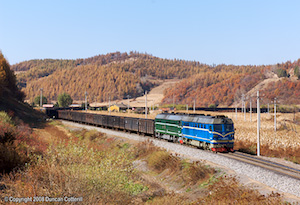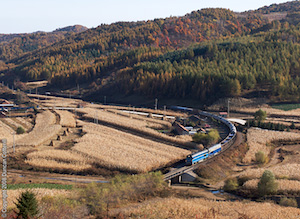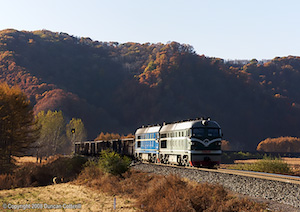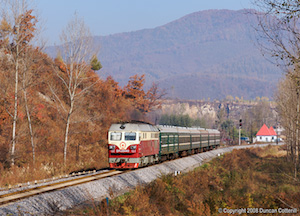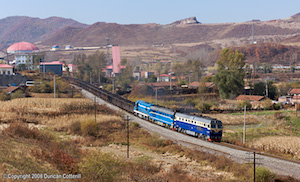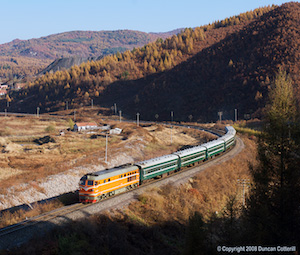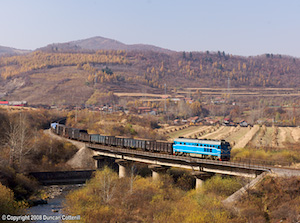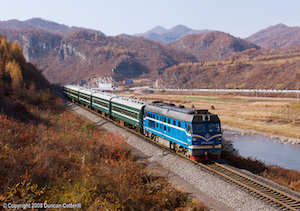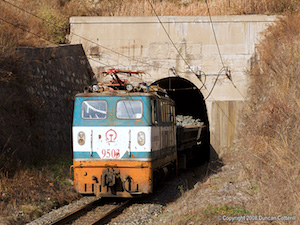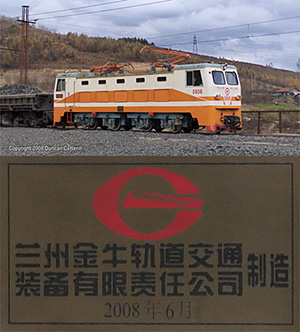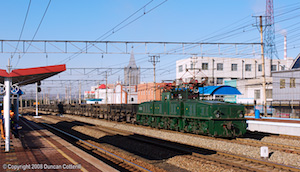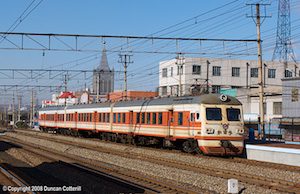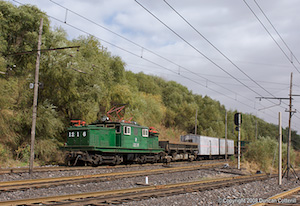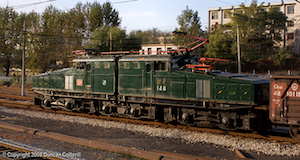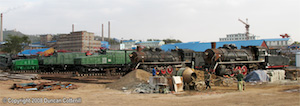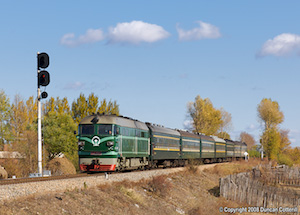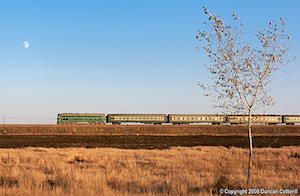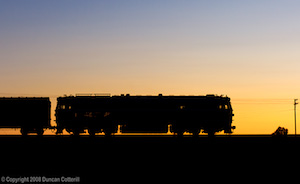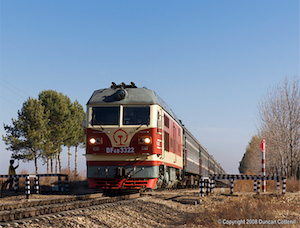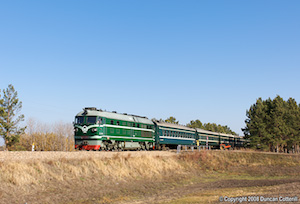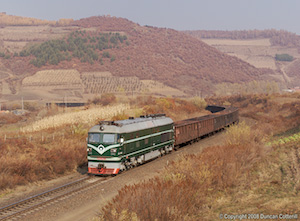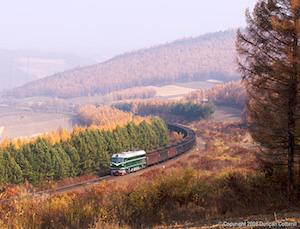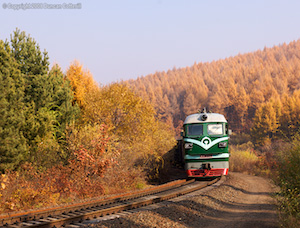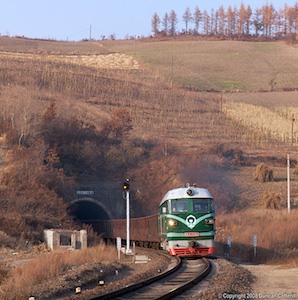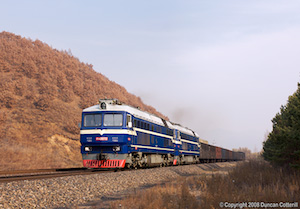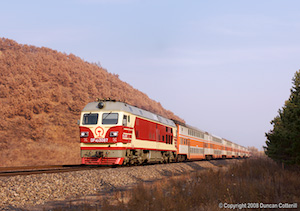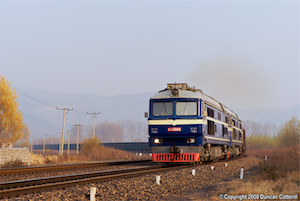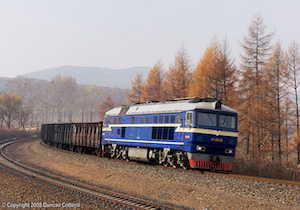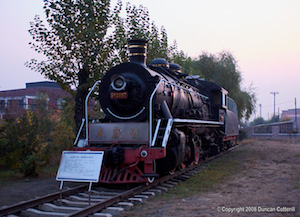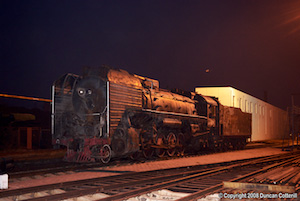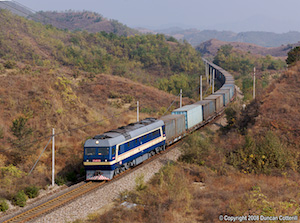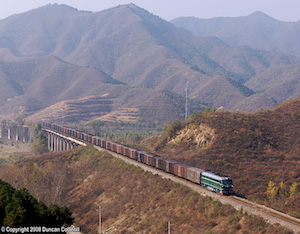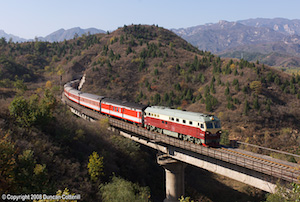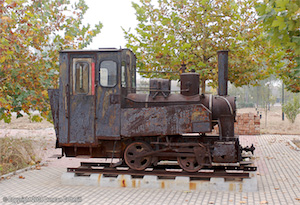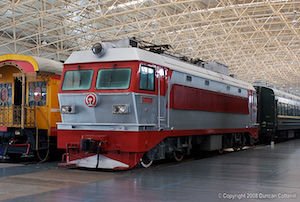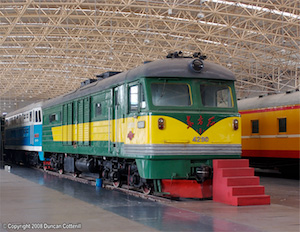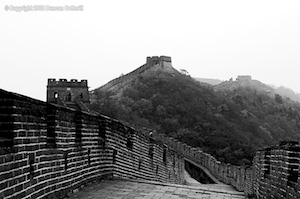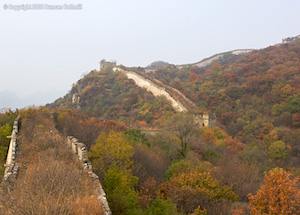North-East Diesels
05 - 22 October 2008
Report by Duncan Cotterill
Introduction
This was my second modern traction trip to China and concentrated on a number of locations in the North-East of the country, mainly places I'd been to many years earlier to photograph steam. The principal objective was to photograph diesels on scenic main lines but several unusual classes were also targeted (rather unsuccessfully). Steam and electrics weren't entirely ignored either.
Following the retirement of Sun Xiaolan, my regular guide and trip organiser for over 10 years, I asked Mike Ma to arrange this trip. Mike also accompanied me throughout as a guide.
In the past I've always used CNR to denote China's national railway but these initials are now used by the China Northern Locomotive & Rolling Stock Corporation, the parent company of all the manufacturing and heavy repair works in northern China including Datong, Dalian, February 7th and Sifang. There's a corresponding CSR covering southern China. As the railway seems increasingly to refer to itself as "China Railway", the use of CR is now more appropriate.
Beijing – Shenyang – Tonghua
(05-06 Oct 2008)I flew from London to Beijing on Air China flight CA938 (Boeing 747-400 Combi B-2469 if anyone’s interested) and met Mike Ma in the new Terminal 3 shortly after arrival. We travelled on the new Airport Express Rapid Transit to Dongzhimen then caught the Metro to Beijing Zhan (Main Station). The Airport Express was worth doing once for the experience but it wasn't particularly rapid and travelled via Terminal 2, so the Airport Bus would have been cheaper and probably just as quick.
From Beijing we travelled on train D3 at 17:30 to Shenyang Bei. This was a high speed service operated by a pair of CRH5 units and took just over 4 hours for the 700 km journey. The high-speed services appear to be extremely popular and almost every seat was occupied for the entire journey.
Beijing depot contained the usual variety of traction with DF4B, DF4C, DF4D, DF11, DF11G, SS1 and SS9G all noted in addition to at least one twin unit BJ. Shortly after leaving Beijing a DF11Z twin was seen heading into the city on an express passenger. My best guess is that this was Y510 from Qinhuangdao running a little early. Several original DF7 were also seen around Beijing.
I was a little concerned about what would happen at Shenyang as we had been unable to get tickets in advance for either of the overnight trains to Tonghua. There was no need to worry as Mike had a plan (in fact he had several plans) and managed to talk us onto train N185. Before long, we were comfortably ensconced in a soft sleeper compartment and enjoyed a hassle free journey to Tonghua. DF4D 0093 was on the front from Shenyang Bei and presumably remained in charge as far as Meihekou. We arrived at Tonghua the next morning behind an unidentified orange DF4B.
TONGHUA AREA
(06-09 Oct 2008)The network of lines around Tonghua was constructed during WWII to link Meihekou, already a junction with lines to Shenyang, Jilin and Siping, to Ji’an and Dalizi on the Korean Border. The line from Meihekou to Ji’an via Tonghua was opened in 1939 with Yayuan (20km east of Tonghua) to Dalizi via Hunjiang (now officially known as Baishan) following in 1940. Japan needed Chinese raw materials to fuel its war effort and railways from China to the Korean ports were an essential link in the chain. The long line north-east from Hunjiang to Baihe wasn’t opened until 1973 and provided access to the forestry resources in the foothills of the Changbaishan mountains.
It wasn’t easy country for railway building with steep forested hills and deep river valleys. These often ran at right angles to the direction the lines needed to go and the result is an interesting and photogenic group of railways with numerous tunnels and bridges, steep climbs and sharp curves, all set in attractive hilly countryside.
Tonghua maintained a fleet of JS class 2-8-2s right up to the official end of steam on CR and many photographers visited the area from the late 1980s until the last fires were dropped in February 2002.
There was a lot of freight between Meihekou and Tonghua with 11 trains seen in less than 10 hours by the lineside. Traffic levels plummeted further east with only four trains seen in eight hours between Tonghua and Hunjiang and a single train seen on each of two four hour sessions east of Hunjiang. From the two afternoons spent between Tonghua and Hunjiang, it was difficult to discern a regular pattern of workings. East of Hunjiang, there seemed to be an eastbound freight in the morning, either preceding or following train 6345 eastwards.
Most freights were hauled by class DF4C diesels from Jilin or Tongliao depots so Meihekou has probably been relegated to sub-depot status. A couple of locos were seen with different allocation codes but I couldn’t identify them. Double heading appeared to be the norm west of Hunjiang and heavy trains in either direction were also banked on the Tonghua – Meihekou section. Mixed combinations of Jilin and Tongliao locos were common and most locos carried the attractive all-blue livery with relatively few in the old standard blue and cream. A few green DF4Bs also appeared, sometimes on their own and sometimes double heading with DF4Cs. The allocation codes noted on two locos were Tongliao and Shenyang. One triple header comprising two DF4Cs and a DF5 was also seen and appeared to be intentional as all three locos had earlier gone west together light engine. Tonghua employed at least two DF5s on station pilot duties (DF5 1432 and 1912 were noted) and more were seen in the Hunjiang and Meihekou areas.
Passenger train frequencies east of Tonghua appear to have dropped since steam days. The timetable shows two expresses to Baihe, a daytime train from Shenyang or Fuxin and an overnight train from Jilin. In addition there are three stopping passengers from Tonghua to Baihe, Linjiang and Ji’an. Also seen was a lunchtime passenger, A145, 12:50 Tonghua to Hunjiang, returning in mid afternoon (A146?) but not shown in the timetable.
Most passenger trains were worked by orange DF4Bs from Shenyang or Jilin depots. Locos worked through (to Baihe, I presume) on the Fuxin and Jilin trains. The locos off three overnight trains to Tonghua (from Dalian, Baicheng and Beijing) filled in by working the stopping passengers to Baihe, Linjiang and Ji’an respectively. As a result, the lowly stopper to Ji’an ended up with express passenger power in the shape of the Shenyang based DF4D off the Beijing express. The Qingdao – Tonghua express also brought a Shenyang DF4D into the area but it had a relatively short layover at Tonghua before returning to Shenyang. The short Tonghua-Hunjiang and return working was powered by a DF4C.
The area has changed a lot in the 14 years since my last visit. As well as massive urban development in both Tonghua and Hunjiang (or Baishan as it now prefers to be called) some tiny villages have grown into sizeable towns and there are many new or improved roads and better hotels. Vegetation has grown up in places and new lines of concrete poles have been erected, ruining some classic positions but leaving others virtually unchanged from steam days. It came as a bit of a shock to find the first place I visited, the northern approach to the colourfully named “Rabid Dog Summit” near Gangou, almost unrecognisable and totally unphotographable. Fortunately other favourites such as the westbound climb from Daoqing and the bridges west of Dayangcha are still excellent and diesels photograph just as well going downhill as climbing, opening up new possibilities. The weather was predominantly sunny for the first two days, spent on the Tonghua-Meihekou and Tonghua-Hunjiang lines respectively. The third day was much cloudier with weak sunlight at times but generally not when a train was about. The morning was spent a Dayangcha but with a lack of light and a lack of trains, I decided to have a look at the Hunjiang Ironstone Railway in the afternoon. The sun returned on the fourth day prompting a return visit to Dayangcha in the morning and Daoqing in the afternoon before leaving for Tonghua and the train to Fushun.
Locos : DF4B 1500[SY], 2124[SY], 2163[JL], 2172[JL], 2175[JL], 2343[SY], 2345[SY], 2428[SY], 2495[SY], 3282[TL], 7473[?], DF4C 4034[JL], 4044[JL], 4061[JL], 4083[JL], 4090[JL], 4099[JL], 4101[?], 4146[TL], 4180[JL], 4229[?], 4231[JL], 4233[?], 4234[TL], 4236[JL], 4344[JL], 4357[JL], 4397[JL], 4423[JL], 5042[TL], 5142[TL], 5144[TL], 5335[JL], DF4D 0095[SY], 0215[SY], 0304[SY], 0440[SY], DF5 1432[?], 1516[?], 1912[JL].
Depots : JL = Jilin, SY = Shenyang, TL = Tongliao
Hunjiang Ironstone Railway
This 762mm gauge, electrified line brings ironstone from the hills north-east of Hunjiang to a processing plant perched on a hillside on the northern edge of the town. The railway is owned by the Tonghua Iron and Steel Company and appears to be in excellent shape with heavy rail on proper ballast, decent sleepers, colour light signals and remotely operated points. There are huge displays outside the site promoting it as a tourist attraction and making specific mention of the “narrow track railway with special characteristics”. Bilingual Chinese/English signs explaining the function of various items of plant were also seen. The big surprise after such a build-up was how long it took us to get permission to visit the railway. Eventually, we got in and found a number of locos in use including No.0806 carrying Lanzhou 2008/06 plates. From the noises it was making it sounded like it had a modern power electronic control system. Locos noted were 0806, 9407, 9502, 9503 in use and 9202 and 9405 stabled outside the depot. 9202 was a centre-cab 4-wheeler and the others were double-ended Bo-Bos. Externally, the 94xx and 95xx locos appeared to be identical. Apart from 0806, said to be on test, none of the locos appeared to have builders plates. The line was quite busy with 8 workings seen in around 4 hours.
Tonghua Steelworks, Dongtonghua
We called in at the steelworks briefly on the way into Tonghua on 09 October. Two SYs were seen in steam, one stabled at the depot and another shunting, but they didn’t come close enough to be identified and we weren’t allowed to enter the premises. Several diesels were also seen including GK1 0091, 0094, GK1C 0285(0385?), 0388 and 0389.
Tonghua – Fushun
(09 Oct 2008)We travelled from Tonghua to Fushuncheng on train 1408, the 16:28 to Qingdao. DF4D 0215 was on the front from Tonghua to Meihekou and appeared to run round and haul the train on to Shenyang. DF5 1422 was the station pilot at Meihekou. From Fushuncheng, we took a taxi the short distance to our hotel in the centre of Fushun.
FUSHUN
(10 Oct 2008)Fushun has been a major coal mining centre for over a century and is also home to steelworks, chemical plants and other industries that rely on rail transportation. The most impressive railway operation in the Fushun area is the electrified network serving the opencast coal mine and associated industries. Operations are centred around the West Pit, an extensive opencast coal mine that also produces significant volumes of oil shale. The installation of a conveyor system from the lower levels of the mine a few years ago has reduced the volume of rail traffic but there is still plenty to see.
The day started with a visit to Kuangwuju passenger station in the centre of town where the morning passenger rush was observed. One of the old Japanese EMUs was seen but unfortunately not photographed. All the other passenger trains were worked by the modern Chinese built units, including No 807, which looked brand new. Several spoil trains and a train of oil tanks were also seen, worked by 37E and ZG150 type locos respectively.
After 09:30, when the passenger service ceased, we moved on to a spot one level down in the opencast pit where trains entering or leaving the pit could be seen. Trains of spoil or coal were worked by the Czech built 37E Bo'Bo'Bo locos and three of the old Japanese ED85 Bo-Bos were seen on lighter duties. SY 0869 also passed with a construction train.
Next stop was Guchengzi, the site of the washery at the south-west corner of the big pit. Most trains here were worked by the Xiangtan built ZG150 Bo+B'o+Bos but two ED85s were also seen. Several locos have been plinthed nearby at the visitor overlook for the big pit but the area was still under construction and we couldn’t get too close. SY 0628 and SY 0715 were identified but the four electric locos of types ZG150, EL1, 37E and ED85 had just been repainted and no numbers were visible.
When the passenger service restarted at 15:30, we took a train to Yulin, changed onto another to Laohutai then finally returned to Kuangwuju. All the passenger trains ridden on and seen were worked by the newer units. Four ED85s were seen during the journey, bringing our total up to 7 or 8 depending on whether the loco lurking behind some wagons at Dongguantun had been seen before or not.
There has clearly been some further renumbering as ED85s numbered 610 and 615 were seen as well as ZG150s numbered 626, 627 and 629. None of these are shown in the latest IRS book. Curiously 615 is listed but as a ZG150, while the one I saw (twice) was almost certainly an ED85.
Apart from the plinthed example at the overlook, none of the LEW type EL1 Bo+B'o+Bos were seen.
The weather was mixed with long clear periods at times and almost total overcast at others. Photography wasn’t easy due to the fairly haphazard poling and the urban environment that the line runs through but we did manage to get a few presentable shots, including a couple of the ED85s.
Locos (all in service except where shown) :
Old EMU 101
ZG150 131, 132, 148, 626, 627, 629
ZG100 618
New EMU 805, 806, 807, 809, 810
ED85 610, 615, 1205, 1211, 1213, 1216, 1218
37E 1513, 1519, 1522, 1525, 1529, 1535, 1537, 1538, 1546
SY 0628*, 0715*(TS 73/09), 0869(TS 74/08)
* = Plinthed.
Fushun – Bei’an
(10-11 Oct 2008)From Fushun, we travelled to Shenyang by road and caught train 2185 (Dandong-Qiqihaer) to Bei’an, arriving the following morning. The motive power from Shenyang to Harbin wasn’t seen but we had DF4D 3086 on the front from Harbin to Bei’an and the same loco continued to Qiqihaer. Observations en-route (i.e. north of Suihua) were DF4 7382[?], 9043[HRB] on freights, DF4 1400[?], DF4D 0386[?] on passengers 6210 & N10 respectively and DF5 1706[HRB], 1709[?] pilots at Hailun and Bei’an respectively.
Depots : HRB = Harbin
BEI’AN
(11-13 Oct 2008)Bei’an is a farming town in the far north of Heilongjiang province. The landscape is unspectacular, consisting of gently rolling farmland stretching as far as the eye can see and rail traffic levels are low.
The lines from Suihua and Qiqihaer to Bei’an were built in the mid 1930s along with a 303km branch north to Heihe on the Russian border. The Heihe line was stolen by Soviet forces in 1946 but the first 63km to Longzhen were reopened in 1963. Although a short section from Heihe was operated as a narrow gauge line from 1950 to 1986, it took until 1989 for the standard gauge to be reinstated throughout as the Heihe Local Railway.
Although the history of the area’s railways was interesting, there had to be a better reason to visit such an unpromising area. In fact, there were two reasons. The Heihe Local Railway had a roster of old DF1 class diesels and CR used locos of class DF7D in the area, both rare classes. Unfortunately, neither class was seen during my visit.
The Heihe Local Railway takes over passenger trains from CR at Bei’an and uses its own locos through to Heihe, 303km to the north. All the trains we saw were powered by plain green DF4Bs, indistinguishable from the standard CR locos apart from the four-character allocation code on the side which read “Heihe Tielu”. Several locos appeared to have been acquired new in 2003 (DF4 7697, 7700, 7701 seen) but DF4 6119 was probably bought second-hand from CR. Freight traffic is exchanged at Longzhen so we went there to check for DF1s, just in case. A Heihe Railway DF4 was stabled in the yard waiting for the afternoon freight to arrive from Bei’an. As one leg of the wye, essential for turning the single ended DF1s, hadn’t seen much use for a long time, we had to conclude that the DF1s had probably finished. There’s a very slim possibility that they could still work at the Heihe end of the line but who’s going to go there to find out?
I’d hoped to find the DF7Ds working freights to Longzhen and most trains on the Qiqihaer line. Unfortunately that didn’t happen either. The trains in question were mainly in the hands of more plain green DF4Bs, this time from Harbin, Sankeshu or Qiqihaer depots. The only relief from the sea of green was the use of orange DF4Bs or red and cream DF4Ds on some passenger trains. Even here, there wasn’t much of a pattern. On two days, the Qiqihaer-Dandong train had a DF4D but on the third it arrived behind a standard DF4B. Everything else was worked by standard or passenger DF4Bs, seemingly at random. Sankeshu has some standard DF4Bs painted in passenger orange just to confuse matters (DF4 1400, 1492 and 1776 were seen around Bei'an and Qiqihaer).
Very little freight was actually seen, making it difficult to determine what the normal pattern is. An arrival at Bei’an from the Suihua line at around 11:00 was seen twice as was a departure for Longzhen that either preceded or followed the passenger from Bei’an at 14:51. No other trains were seen more than once.
Despite the lack of real scenery, long sections of line hemmed in by trees and poor road access to many parts of the line, it didn’t prove too difficult to find pleasant photo locations that produced more than acceptable results. The weather was remarkably good on all three days with only a little morning mist interrupting the gloriously clear, bright sunlight. One morning was spent on the Qiqihaer line and the other on the Suihua line. Both afternoons were spent on the Heihe line.
Heihe Local Railway Locos : DF4 6119, 7697, 7700, 7701
CR Passenger Locos : DF4 1066[SKS], 1400[?], 1776[SKS], 2131[SKS], 9312[QQH], DF4D 0386[?], 3086[SKS], 3322[?]
CR Freight Locos : DF4 1213[HRB], 7323[HRB], 7382[?], 9003[QQH], 9043[HRB], 9303[?]
Depots : HRB = Harbin, QQH = Qiqihaer, SKS = Sankeshu (Harbin)
Forestry Railways
There used to be three narrow gauge forestry railways around Bei’an but the decline of logging and the switch to road transport have taken their toll. The northernmost system, from Zhanhe on the Bei’an-Longzhen line, was reported closed in 2002 and Google Earth clearly shows the wood yard, depot and station area devoid of track. Although I passed Zhanhe by road, a visit seemed pointless. I’d prefer to remember it as a working railway.
The Tongbei system closed around 10 years ago and, as expected, no trace of it was seen from the train as we passed. The third system, from Suiling/Suileng on the Suihua-Bei’an line was seen from the train and appeared to be intact and probably still operational. The yard was full of wagons and the track could be seen heading off towards the distant forests. No locos were seen but they would have probably been stored under cover at this time of year, waiting for the start of the logging season in November.
Bei’an to Mudanjiang
(13-14 Oct 2008)Instead of taking the obvious route via Suihua and Harbin, we took train 4084 from Bei’an to Qiqihaer then train N54/N55 overnight from Qiqihaer to Mudanjiang, bagging some new track and avoiding a long, late-night wait at Harbin.
Mike had no difficulty buying our Qiqihaer - Mudanjiang sleeper tickets from the booking office at Bei'an but the Bei'an - Qiqihaer tickets weren't as easy. Despite the train having hard and soft sleeper coaches, they would only sell hard seat tickets on train 4084 to Qiqihaer. The train crew were very keen to upgrade us and we enjoyed the journey in the relative comfort of a sparsely populated hard sleeper.
Train 4084 was an interesting experience as it was a Heihe Local Railway train, staffed by an HLR crew but worked from Bei’an to Qiqihaer by a CR loco (DF4 2131) over CR metals. It was clear that we were the lowest priority service on the line, booked to wait for long periods in loops to cross everything coming in the other direction, including freights. More than a quarter of the journey was spent waiting in this way. The most interesting observation was the complete absence of DF7Ds anywhere en-route. All passengers and freights were DF4 hauled, mainly by standard DF4Bs with a handful of passenger DF4Ds also seen. Observations between Bei'an and the junction of the Nenjiang line at Fuyu are included in the Bei’an lists above. The following were seen between Fuyu and Qiqihaer.
Passenger Locos : DF4 1492[SKS], 1506[SKS], DF4D 0385[SKS]
Freight Locos : DF4 1738[QQH], 1855[QQH], 3474[QQH]
After arrival at Qiqihaer, fast train T507 from Harbin was seen, formed of a DF4DK hauling the coaches of a class NYJ1 diesel unit. From Qiqihaer, DF4D 3236 hauled us east on train N54/N55.
MUDANJIANG
(14-17 Oct 2008)The first railway to reach Mudanjiang was the Chinese Eastern Railway, opened in 1901. This was a section of the original Trans-Siberian route that cut directly across Manchuria via Manzhouli, Hailaer, Harbin, Mudanjiang and Suifenhe to reach Vladivostok. In common with the rest of the line, it was originally built to 5’ (1520mm) gauge but was regauged to standard after coming under Japanese control in the mid 1930s. The line north to Jiamusi was built by the Japanese in the late 1930s but the link south to Tumen wasn’t opened until the late 1960s.
Mudanjiang – Xiachengzi
This line heads east of Mudanjiang towards Suifenhe on the Russian border and was part of the Chinese Eastern Railway. A number of stone arch bridges from the original line still exist and make a nice change from the usual concrete beam structures found everywhere in China. Between Modaoshi and Daimagou the line climbs to a summit via a series of horseshoe curves and this area was a favourite destination for steam photographers during the late 1980s and early 1990s.
Most passenger trains now run during the hours of darkness but those we did see were worked by passenger DF4Ds from Sankeshu depot. Train 2728 from Suifenhe to Shenyang was formed of double-deck stock, the first time I can remember seeing double-deckers north of Shenyang.
Freights were all hauled by standard green DF4Bs based at Mudanjiang and there was a significant imbalance between eastbound and westbound traffic. On one day we saw six eastbounds and one westbound in a period of around seven hours at the lineside. Another day produced four eastbounds and two westbounds in six hours. On two of the three afternoons I spent in the area, there were westbound freights at around 13:00 and 14:00. On both occasions, the first train was triple headed and the second double headed. Only one double headed eastbound was seen.
Apart from the inevitable mobile phone masts, the village of Shandi in the middle of the lower horseshoe east of Modaoshi hardly seemed to have changed since the early 1990s. Several of the photo locations were also just as I remember them while others had become overgrown. The number of daytime passenger trains seemed to have declined but there was still enough action to keep me happily occupied.
Locos : DF4 1380[?], 1390[MDJ], 1392[MDJ], 1964[MDJ], 1976[MDJ], 1977[MDJ], 1985[MDJ], 3795[MDJ], 3802[MDJ], 3805[MDJ], 3806[?], 3807[MDJ], 7100[MDJ], 7116[MDJ], 7118[MDJ], 9291[MDJ], 9305[MDJ], DF4D 0107[SKS], 0367[SKS], 0427[SKS], 0432[SKS].
Depots : MDJ = Mudanjiang, SKS = Sankeshu (Harbin)
Mudanjiang – Harbin
This busy double track main line was also part of the original Chinese Eastern Railway and links Mudanjiang, the third largest city in Heilongjiang with the provincial capital of Harbin. The line follows the valley of the Hailin River and one of its tributaries westwards, climbing to a significant summit in mountainous country between Hengdaohezi and Yabuli. Freight traffic is heavy, with coal traffic from the Jixi area predominating. There are also numerous regional and long distance passenger trains. The Quail Atlas shows two routes from Zhishan, just west of Hengdaohezi, over the summit to Yabuli but the southern route, the original line, has been closed for several years and the vegetation growing between the rails reaches head height in places.
All the passenger trains observed were hauled by class DF4DK locos from Sankeshu depot in Harbin. This included trains N1, N2 and N4, previously rostered for class NYJ1 diesel unit trains. N2 was formed of a set of trailers from one of the diesel units but N1 and N4 used a set of double deck hauled stock.
Freight power was a mixture of DF8 and DF4B diesels with around 5 times as many DF8s as DF4Bs. Apart from one Harbin DF4B, all the locos identified were based at Mudanjiang. About 50% of trains were double headed, mainly westbounds, with several DF8 + DF4B combinations seen. A number of eastbound light engines were also seen, balancing the double headers going the other way. At times the freights were passing at 10 minute intervals but there were gaps of up to an hour at other times. We missed so many trains while looking for locations that it would be difficult to estimate the total number of trains seen in a day.
Photography was difficult due to a combination of poor road access to the line, too many trees alongside the line and a lack of elevated viewpoints on the sunny side, not that there was a vast amount of sunlight.
Locos : DF4 1822[HRB], 1925[MDJ], 1972[MDJ], 7332[MDJ], 9308[MDJ],
DF4D 3034[SKS], 3037[SKS], 3087[SKS], 3246[SKS], 3296[SKS], 3303[SKS], 3312[SKS],
DF8 0044[MDJ], 0045[MDJ], 0049[MDJ], 0057[MDJ], 0059[MDJ], 0063[MDJ], 0066[MDJ], 0072[MDJ], 0075[MDJ], 0079[MDJ], 0081[MDJ], 0082[MDJ], 0090[MDJ], 0092[MDJ], 0094[MDJ], 0105[MDJ], 0109[MDJ], 0110[MDJ], 0116[MDJ], 0124[MDJ], 0127[MDJ],
Depots : HRB = Harbin, MDJ = Mudanjiang, SKS = Sankeshu (Harbin)
Mudanjiang – Linkou
This double track main line connects the Qitaihe and Jixi coalfields to Mudanjiang and hosts heavy freight traffic and several daily passenger trains. The line runs through attractive hilly country in places.
My only visit to this line got off to a very slow start due to road works that prevented us taking the main road from Mudanjiang north to Chaihe. After following a series of farm tracks to Chaihe then cutting across to the main Jixi road and back to the line at Wulin, we finally found some acceptable locations north of Zhujiagou. It had taken more than two hours to get there but petty officialdom intervened after less than 30 minutes and we were told to leave the area or else there would be big trouble. Mr Angry seemed to be very serious and Mike was concerned so we baled out, heading for Modaoshi where the car promptly exploded, or at least part of the cooling system did, spraying hot water and steam everywhere. It wasn’t turning out to be a good day!
Locos : DF4 7177[MDJ], DF8 0042[MDJ], 0059[MDJ], 0073[MDJ], 0094[MDJ], 0118[MDJ], 0139[MDJ],
Depots : MDJ = Mudanjiang
Chaihe Forestry Railway
This narrow gauge line closed a long time ago but the viaduct over the Mudan River is still in use as a very narrow road bridge, which we drove across. The loco shed was also recognisable and now serves as a garage for lorries. Chaihe Works, where many of the north-east’s narrow gauge locos were overhauled, is still in business but now produces domestic heating boilers.
Steam Around Mudanjiang
SY 0967(TS 75/03), formerly reported dumped at Mudanjiang Coal & Coke Works, is plinthed outside the offices at the CR Loco Depot and can be glimpsed from passing trains. It’s also just about visible from the public side of the main gate. Also stored at the depot is QJ 6980, formerly hired to the cement works at Wenchun. Its future appears to be uncertain but I got the distinct impression that the depot management would like to preserve it. The QJ can easily be seen from passing trains. Depot staff confirmed that there are no industrial locations in the Mudanjiang area still using steam.
Other preserved locos include two C2 narrow gauge locos at a factory on the main road to Suifenhe, a few km west of Modaoshi, and an SY and another C2 plinthed on the platform at Mudanjiang station.
Mudanjiang – Huairou
(17 Oct 2008)We flew from Mudanjiang to Beijing on the evening of 17 October (Hainan Airlines flight HU7104 737-800), then took a taxi to Huairou, our base for visiting the Beijing – Longhua line.
Beijing – Longhua Line
(18-21 Oct 2008)The railway from Beijing to Tongliao via Longhua and Chifeng was opened around 1981 and may have been diesel operated from the outset. The steep gradients and long tunnels on the Beijing-Longhua section certainly weren’t suited to steam operation. I visited the line in October 2006 but only went to a couple of locations. The aim of this year’s trip was to explore the mountainous area around Miyun Reservoir and on to Gubeikou. My base for four days in the area was Huairou, a bustling town on the plains around 70km north of Beijing and close to where the Longhua line enters the mountains.
Huairou Bei based DF8B now work the vast majority of freights on the line. Old DF4s from the same depot still appear occasionally but I wasn’t prepared for just how old! DF4 0008 was seen on Sat 18 and Sun 19 Oct. Freight traffic and timings were variable from day to day but 3 or 4 trains each way in daylight would seem to be normal.
Passenger trains were all worked by standard DF4s from Huairou Bei depot during my previous visit in October 2006 but the situation has now become considerably more interesting. Most of the long distance trains, i.e. to/from Chifeng and beyond were hauled by Tongliao based DF4D with a mixture of Huairou Bei based standard DF4A and passenger DF4B on the shorter distance trains. Train 2190 from Wulanhaote also seemed to get a DF4A.
North of Huairou Bei, the railway runs into the mountains that surround Beijing on three sides. The line skirts the western edge of the massive Miyun Reservoir to Shitanglu before following a spit of land to a point where the northernmost arm of the lake is narrow enough to bridge. The line then runs parallel to the north shore of the lake along a broad valley, gradually gaining height by climbing along the flanks of the hills to the north. The mountains close in again at Gubeikou and the section north to Wudaohe is really spectacular with high mountains dropping precipitously to the valley floor way below. The railway’s builders made no attempt to follow the contours on this section and built a line that consists almost entirely of tunnels and high viaducts. There are few roads in the area and they often run far from the railway, so access is a problem. We found a number of good locations all along the line, far more than we could cover during the one day of good light.
Locos : DF4 0008[?], 0400[HRO], 0573[HRO], 2274[HRO], 2276[HRO], 2352[HRO], DF4D 0039[TL], 0255[TL], 0256[TL], 0259[TL], 0305[?], 0436[?], 0547[?], DF8B 0008[HRO], 5090[HRO], 5093[HRO], 5105[HRO], 5289[?], 5305[HRO] .
Depots : HRO = Huairou Bei, TL = Tongliao
Beijing Railway Museum
(22 Oct 2008)I visited the museum on the final morning before heading to the airport. Three new locomotives have arrived since my last visit in November 2007, a small metre gauge 0-4-0T plinthed outside in poor condition, an SS5 electric and a DFH1 diesel. On the test track outside, one of the new Dalian/EMD built class HXN3 diesels was performing tests with a pair of Siemens/Xuzhou twin unit class HXD1 electrics providing the load. The HXN3 appeared to be unsilenced and was making a very satisfying noise.
Then it was off to the airport for a delayed CA937 back to London (747-400 Combi B-2469).
Comments
It was a bit of a mixed trip overall. The Tonghua-Hunjiang area was excellent, Fushun was enjoyable and Bei’an much better than might have been expected with so few trains, no scenery and no interesting engines. Apart from one brilliantly clear day at Huairou, the weather was problematic for the rest of the trip with a lot of cloud, poor visibility and, little strong sunlight.
If the whole trip had been as good as the first four days at Tonghua, I'd have been ecstatic. Plenty of brilliant light, very photogenic engines in the shape of blue DF4Cs and orange DF4Bs, nice locations and glorious autumn colours. This was Chinese diesel photography at its best.
It was nice to see so many of the old ED85 electrics still in service at Fushun. The newest of these is now well over 60 years old and it’s surprising that they’ve outlasted many of the newer machines introduced from the late 1950s onwards.
The lack of DF1s at Bei’an wasn’t too much of a shock. When I first saw them in 1999, they were looking a bit tired so it was remarkable that they lasted as long as they did. The last report of DF1s in use was in October 2006. As far as I’m aware, very few of the class remain in industrial service and they can no longer be found anywhere on line work.
The complete absence of DF7Ds was more unexpected. This class was built less than 10 years ago and came in two variants. The locos seen around Bei’an in the past were the extreme cold weather version numbered in the 3xxx series. This part of Heilongjiang is just across the border from Siberia and experiences extremely low winter temperatures. It’s difficult to think of anywhere much colder that they could be sent. DF7D may still used on the remote lines further west (Nenjiang – Jiagedaqi – Yitulihe area) but they seem to have been displaced from the Bei’an area by older DF4Bs.
Mudanjiang was very disappointing. The DF8s are unusual and very photogenic engines and there were plenty of them around. However, I struggled to get any decent pictures of them. With no DF1s, no DF7Ds and very few decent pictures of DF8s, it was turning into a mega DF4 fest.
It was no great surprise to see that the NYJ1 diesel units have been replaced by loco hauled rakes. They never appeared robust enough to last long in front line express passenger service.
The Beijing – Longhua line has tremendous photographic potential but there aren’t that many trains and the locations are often fairly inaccessible despite their proximity to Beijing. Well worth doing if you get the weather and the Beijing smog doesn't come visiting.
Seeing DF4 0008 at work was a real shock. I had thought that all the first series locos, built in the early 1970s, had gone for scrap years ago. The first time I saw it, I wasn’t close enough to be absolutely sure of the number but the second time there was no doubt. Eight is a lucky number for the Chinese and it certainly hasn’t done this particular loco any harm.
One development that I hadn't appreciated before concerns the CR timetable. When preparing for the trip, I'd noticed that there seemed to be less local trains than in the past and those that remained stopped at less stations. Times were obtained from TravelChinaGuide and cross-checked with Shike, which is more difficult to use but tends to be more up-to-date. A paper timetable bought at Beijing confirmed the service pattern even if some times were marginally different. However, a number of services numbered in the Axxx series were noted on the departure boards at various stations, in addition to the Tonghua - Hunjiang train actually photographed. None of these appear in the web or paper timetables. Where local trains were listed in the timetable, they often stopped at more stations than those listed. The Bei'an - Qiqihaer train I travelled on stopped at several unlisted stations as did trains on the Huairou Bei - Longhua line. It appears that the national timetable is considerably less comprehensive than it used to be.
I usually end these reports by saying that China is a great place to photograph trains and how I can't wait to go back. Regrettably I can't be quite as positive this time.
A Word of Warning
One of the things I always liked about China was the relaxed attitude towards railway photography. Occasionally there were problems taking pictures in certain areas but the basic act of taking pictures of trains was almost never questioned. It was just an inexplicable but harmless thing that foreigners did.
Unfortunately, that’s no longer the case and friendly curiosity has turned to suspicion and even hostility. Instead of a smile and a wave, the average track worker is more likely now to give you a scowl and report your presence via his mobile phone. The attitude of locals unconnected with the railway is also less welcoming with the first question more likely to be an unfriendly “Why have you come here?” rather than a curious “Where are you from?”. Having a guide was extremely useful and Mike Ma spent a lot of his time reassuring people that I wasn’t about to commit some terrible crime.
Something has changed in China and it seems to have put the idea into people’s heads that any foreigner with a camera, close to a railway line is probably up to no good, rather than pursuing an innocent hobby. It certainly wasn't like this on my previous modern traction trip two years ago and heightened security fears surrounding the Olympics are probably to blame. But why pick on railway photographers? As far as I’m aware, nobody has yet brought a state to its knees by taking pictures of trains.
Visitors to the mainstream steam locations probably won’t notice much difference as foreign enthusiasts have long been part of the scene and people are used to our presence. Anyone straying off the beaten track or photographing on the main line needs to be aware that their presence near a railway with a camera is likely to be much less welcome than it was in the past.
Apart from Mr Angry at Zhujiagou, we didn’t have any actual trouble, although the less than friendly attitude of the locals in some places did make the trip a lot less relaxing and enjoyable than it should have been. By the end of the trip, I was getting totally fed up with it all to the extent that I spent the last full day climbing the Great Wall instead of photographing trains.
Will it put me off going back to China? Not completely, but I’m much less likely to do another diesel trip in the next year or so. Hopefully the fuss will all die down and things will return to normal. It will be a great shame if China becomes a difficult country as its railways are undoubtedly the most interesting in the world at the moment.
